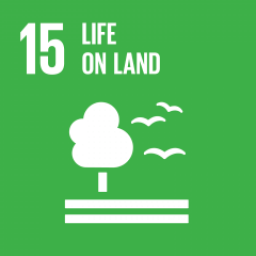SDG 15 - Life on Land

Protect, restore and promote sustainable use of terrestrial ecosystems, sustainably manage forests, combat desertification, and halt and reverse land degradation and halt biodiversity loss
Most countries in the region retain sizeable sections of forested area, although habitat loss continues to be a risk due to unsustainable logging practices and forest conversion for plantation and agricultural uses. Invasive species are the leading cause of species extinction on island ecosystems and can impact food and economic security. A regionally co-ordinated response is in place for the management of invasive species in the Pacific.
Ecosystem-based approaches are being integrated into national and sector plans, with potential benefits including enhanced livelihood opportunities and food security; increased biodiversity conservation; and improved carbon sequestration and sustainable water management. The Red List Index, is an indicator of changes in biodiversity and species extinction risk over time.
By 2020, ensure the conservation, restoration and sustainable use of terrestrial and inland freshwater ecosystems and their services, in particular forests, wetlands, mountains and drylands, in line with obligations under international agreements
Indicator 15.1.1: Forest area as a proportion of total land area
Click on column to access corresponding country data time series
Click on column to access corresponding country data time series
Indicator 15.1.2: Proportion of important sites for terrestrial and freshwater biodiversity that are covered by protected areas, by ecosystem type
By 2020, promote the implementation of sustainable management of all types of forests, halt deforestation, restore degraded forests and substantially increase afforestation and reforestation globally
Indicator 15.2.1: Progress towards sustainable forest management
NOTE: this indicator is not one of the 132 indicators in the Pacific SDG indicator subset
By 2030, combat desertification, restore degraded land and soil, including land affected by desertification, drought and floods, and strive to achieve a land degradation-neutral world
Indicator 15.3.1: Proportion of land that is degraded over total land area
NOTE: this indicator is not one of the 132 indicators in the Pacific SDG indicator subset
By 2030, ensure the conservation of mountain ecosystems, including their biodiversity, in order to enhance their capacity to provide benefits that are essential for sustainable development
Indicator 15.4.1: Coverage by protected areas of important sites for mountain biodiversity
NOTE: this indicator is not one of the 132 indicators in the Pacific SDG indicator subset
Indicator 15.4.2: Mountain Green Cover Index
NOTE: this indicator is not one of the 132 indicators in the Pacific SDG indicator subset
Take urgent and significant action to reduce the degradation of natural habitats, halt the loss of biodiversity and, by 2020, protect and prevent the extinction of threatened species
Indicator 15.5.1: Red List Index
Promote fair and equitable sharing of the benefits arising from the utilization of genetic resources and promote appropriate access to such resources, as internationally agreed
Indicator 15.6.1: Number of countries that have adopted legislative, administrative and policy frameworks to ensure fair and equitable sharing of benefits
Take urgent action to end poaching and trafficking of protected species of flora and fauna and address both demand and supply of illegal wildlife products
Indicator 15.7.1: Proportion of traded wildlife that was poached or illicitly trafficked
Visualisation(s) not yet available
No data for indicator 15.7.1 is currently available.
By 2020, introduce measures to prevent the introduction and significantly reduce the impact of invasive alien species on land and water ecosystems and control or eradicate the priority species
Indicator 15.8.1: Proportion of countries adopting relevant national legislation and adequately resourcing the prevention or control of invasive alien species
Visualisation(s) not yet available
View 15.8.1 data on PDH.stat
By 2020, integrate ecosystem and biodiversity values into national and local planning, development processes, poverty reduction strategies and accounts
Indicator 15.9.1: (a) Number of countries that have established national targets in accordance with or similar to Aichi Biodiversity Target 2 of the Strategic Plan for Biodiversity 2011–2020 in their national biodiversity strategy and action plans and the progress reported towards these targets; and (b) integration of biodiversity into national accounting and reporting systems, defined as implementation of the System of Environmental-Economic Accounting
NOTE: this indicator is not one of the 132 indicators in the Pacific SDG indicator subset
Mobilize and significantly increase financial resources from all sources to conserve and sustainably use biodiversity and ecosystems
Indicator 15.A.1: (a) Official development assistance on conservation and sustainable use of biodiversity; and (b) revenue generated and finance mobilized from biodiversity-relevant economic instruments
NOTE: this indicator is not one of the 132 indicators in the Pacific SDG indicator subset
Mobilize significant resources from all sources and at all levels to finance sustainable forest management and provide adequate incentives to developing countries to advance such management, including for conservation and reforestation
Indicator 15.B.1: (a) Official development assistance on conservation and sustainable use of biodiversity; and (b) revenue generated and finance mobilized from biodiversity-relevant economic instruments
NOTE: this indicator is not one of the 132 indicators in the Pacific SDG indicator subset
Enhance global support for efforts to combat poaching and trafficking of protected species, including by increasing the capacity of local communities to pursue sustainable livelihood opportunities
Indicator 15.C.1: Proportion of traded wildlife that was poached or illicitly trafficked
NOTE: this indicator is not one of the 132 indicators in the Pacific SDG indicator subset